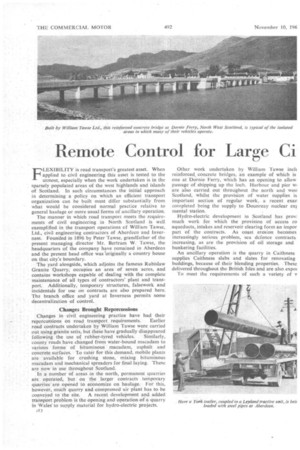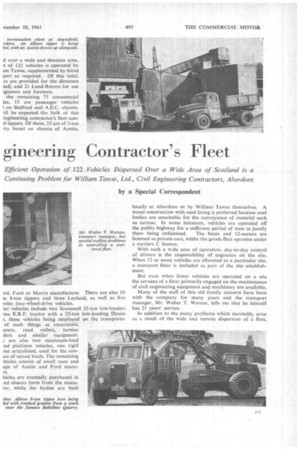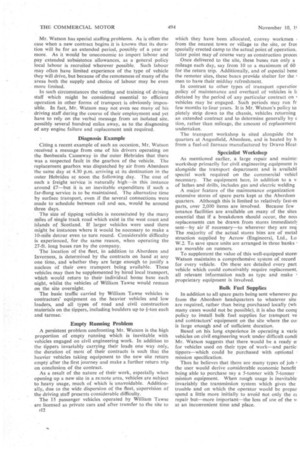Remote Control for Large Ci gineering Contractor's Fleet
Page 136

Page 137

Page 138

If you've noticed an error in this article please click here to report it so we can fix it.
Efficient Operation of 122 Vehicles Dispersed Over a Wide Area of Scotland is a Continuing Problem for William Tawse, Ltd., Civil Engineering Contractors, Aberdeen
by a Special Correspondent
FLEXIBILITY is road transport's greatest asset. When applied to civil engineering this asset is tested to the
utmost, especially when the work undertaken is in the sparsely populated areas of the west highlands and islands of Scotland. In such circumstances the initial approach in determining a policy on which an efficient transport organization can be built must differ substantially from what would be considered normal practice relative to general haulage or more usual forms of ancillary operation.
The manner in which road transport meets the requirements of civil engineering •in North Scotland is well exemplified in the transport operations of William Tawse, Ltd., civil engineering contractors of Aberdeen and Inverness. Founded in 1896 by Peter Tawse, grandfather of the present managing. director Mr. Bertram W. Tawse, the headquarters of the company have remained in Aberdeen and the present head office was 'originally a country house on that city's boundary.
The yard. alongside, which adjoins the famous Rubislaw Granite Quarry, occupies an area of seven acres, and contains workshops capable of dealing with the complete maintenance of all types of contractors' plant and transport. Additionally, temporary structures, falsework and incidentals for use on contracts are also prepared here. The branch .office and yard at Inverness permits some decentralization of control.
Changes Brought Repercussions
Changes in civil engineering practice have had their repercussions on road transport, requirements. Earlier road contracts undertaken by William Tawse were carried out using granite setts, but these have gradually disappeared
following the use of rUbber-tyred vehicles, Similarly, county roads have changed from water-bound macadam to various formsof bituminous macadam, . asphalt and concrete surfaCes. To cater for this demand, mobile plants are available for crushing stone, mixing bituminous macadam and mechanical spreaders for final laying. These are now in use throughout • Scotland.
. In anumber of -areas in the north, permanent quarries aft operated, but on the larger contracts ternporary quarries are onened to economize on haulage. • For this, hoWever, muth quarry and compressed air plant has to be conveyed to the site. A recent. development and added transport-problem iS the opening.and operation of a quarry in Wales' to supply material for hydro-electric projects. Other work undertaken by William Tawse inch reinforced concrete bridges, an example of which is one at Dornie Ferry, which has an opening to allow passage of shipping up the loch. Harbour and pier wi are also carried out throughout the north and west Scotland, whilst the provision of water supplies is important section of regular work, a recent exan completed being the supply to Dounreay nuclear ex' mental station.
Hydro-electric development in Scotland has provi much work for which the provision of access ro aqueducts, intakes and reservoir clearing form an impor part of the contracts. As coast erosion becomes increasingly serious problem, sea defence contracts increasing, as are the provision of oil storage and bunkering facilities.
An ancillary operation is the quarry in Caithness supplies Caithness slabs and slates for renovating buildings, because of-their blending properties. These delivered throughout the British Islesand are also expoi To meet the requirements of such a variety of v d over a wide and desolate area, ot of 122 vehicles is operated by tm Tawse, supplemented by hired port as required. Of this total, ,rs are provided for the directors taff, and 21 Land-Rovers for use igineers and foremen.
the remaining 75 commercial les, 15 are passenger vehicles F on Bedford and A.E.C. chassis. be expected the bulk of this .:ngineering contractor's fleet contippers. Of these, 25 are of 5-ton oity based on chassis of Austin,
,rd, Ford or Morris manufacture. There are also 10 in 8-ton tippers and three Leyland, as well as five rolet four-wheel-drive vehicles.
ter vehicles include two Scammelt 25-ton low-loaders me E.R.F, tractor with a 25-ton low-loading Dyson r, these vehicles being employed on the transportaof such things as excavator, ozers, road rollers, tarmac ders and similar equipment.
are also two maximum-load .nd platform vehicles, one rigid me articulated, used for the conice of mixed loads, The remaining !hides consist of small vans and ups of Austin and Ford manure.
hicks are normally purchased in nd chassis form from the manurer, while the bodies are built locally at Aberdeen or by William .Tawse themselves. A wood construction with steel lining is-preferred because steel bodies are unsuitable for the conveyance of material such as tarmac. In some instances, vehicles arc operated off the public highway for a sufficient period of time to justify them being unlicensed. The buses and 12-seaters are licensed as private cars, whilst the goods fleet operates under a carriers C licence.
With such a wide area of operation, day-to-day control of drivers is the responsibility of engineers on the site. When 12 or more vehicles are allocated to a particular site, a transport fitter is included as part of the site establishment.
But even when fewer vehicles are operated on a site the services of a fitter primarily engaged on the maintenance of civil engineering equipment and machinery are available: Many of the staff of this old family concern have been with the company for many years and the transport manager, Mr. Walter T. Watson, tells me that he himself has 21 years' service.
In addition to the many problems which inevitably arise as a result of the wide and remote dispersion of a fleet, Mr. Watson has special staffing problems. As is often the case when a new contract begins it is known that its duration will be for an extended period, possibly of a year or more. As it would be uneconomic to import labour and pay extended subsistence allowances, as a general policy local labour is recruited wherever possible. Such labour may often have limited experience of the type of vehicle they will drive, but because of the remoteness of many of the areas both the supply and choice of labour may be even more limited.
In such circumstances the vetting and training of driving staff which might be considered essential to efficient operation in other forms of transport is obviously impossible. In fact, Mr. Watson may not even see many of his driving staff during the course of their employment and yet have to rely on the verbal message from an isolated site, possibly several hundred miles away, as to the diagnosing of any engine failure and replacement unit required.
Diagnosis Example
Citing a recent example of such an occasion, Mr. Watson received a message from one of his drivers operating on the Benbecula Causeway in the outer Hebrides that there was a suspected fault in the gearbox of the vehicle. The replacement gearbox was dispatched by air from Aberdeen the same day at 4.30 p.m. arriving at its destination in the outer Hebrides at noon the following day. The cost of such a freight service is naturally high—in this instance around 0—but it is an inevitable expenditure if such a far-flung service is to be maintained. The alternative time by surface transport, even if the several connections were made to schedule between rail and sea, would be around three days.
The size of tipping vehicles is necessitated by the many miles of single track road which exist in the west coast and islands of Scotland. If larger vehicles were used there might be instances where it would be necessary to make a 10-mile detour even to turn round. Considerable difficulty is experienced, for the same reason, when operating the 27-ft. long buses run by the company.
The location of the fleet, in addition to Aberdeen and Inverness, is determined by the contracts on hand at any one time, and whether they are large enough to justify a nucleus of their own transport being available. These vehicles may then be supplemented by hired local transport, which would return to their individual home base each night, whilst the vehicles of William Tawse would remain on the site overnight.
The basic traffic carried by William Tawse vehicles is contractors' equipment on the heavier vehicles and low loaders, and all types of road and civil construction materials on the tippers, including boulders up to +-ton each and tarmac.
Empty Running Problem
A persistent problem confronting Mr. Watson is the high proportion of empty running which is inevitable with vehicles engaged on civil engineering work. In addition to the tippers invariably carrying their loads one way only, the duration of most cif their contracts is such that the heavier vehicles taking equipment to the new site return empty after the first journey and make a further return trip on conclusion of the contract.
As a result of the nature of their work, especially when opening up a new site in a remote area, vehicles are subject to heavy usage, much of which is unavoidable. Additionally, due to the wide dispersion of the fleet, supervision of the driving staff presents considerable difficulty.
The 15 passenger vehicles operated by William Tawse are licensed as private cars and after transfer to the site to 112 which they have been allocated, convey workmen 1 from the nearest town or village to the site, or fror specially erected camp to the actual point of operation. latter point may of course vary as construction proce( Once delivered to the site, these buses run only a mileage each day, say from 10 to a maximum of 60 for the return trip. Additionally, and of especial bene the remoter sites, these buses provide shelter for the men to have their midday refreshment In contrast to other types of transport operatior policy of maintenance and overhaul of vehicles is h dictated by the period of any particular contract on vehicles may be engaged. Such periods may run fr few months to four years. It is Mr. Watson's policy to pletely strip down to the chassis, vehicles returning an extended contract and to determine generally by c don, rather than mileage, the amount of replacement undertaken.
The transport workshop is sited alongside the quarters at Angusfietd, Aberdeen, and is heated by h from a fuel-oil furnace manufactured by Drava Heat
Specialist Workshop
As mentioned earlier, a large repair and mainto workshop primarily for civil engineering equipment is alongside the transport department and is availabl special work required on the commercial vehicl necessary. The equipment here, in addition to a v. of lathes and drills, includes gas and electric welding A major feature of the maintenance organization extensive stores of spare parts kept at the Aberdeen quarters. Although this is limited to relatively fast-rn parts, over 2,000 items are involved. Because few tenance facilities are available on many of the sites essential that if a breakdown should occur, the nee( replacements can be drawn from stores immediatell sent—by air if necessary—to wherever they are req The majority of the actual stores bins are of metal struction supplied by Acrow (Engineers), Ltd., Lo W.2. To save space units are arranged in three banks are movable on runners.
To supplement the value of this well-equipped store Watson maintains a comprehensive system of record for every vehicle. On these are detailed every part vehicle which could conceivably require replacement, all relevant information such as type and make , proprietary equipment is involved.
Bulk Fuel Supplies
In addition to all spare parts being sent whenever po from the Aberdeen headquarters to whatever site are required, rather than being purchased locally (wh many cases would not be possible), it is also the corm policy to install bulk fuel supplies for transport ye and contractors' equipment on the site where the coi is large enough and of sufficient duration.
Based on his long experience in operating a vatic vehicles on civil engineering work under difficult condi Mr. Watson suggests that there would be a ready IT for vehicles used on their type of work—and partici tippers—which could be purchased with optional mission specification.
Thus he believes that there are many types of job the user would derive considerable economic benefit being able to purchase say a 5-tonner with 7-tonner mission equipment. When rough usage is inevitable invariably the transmission system which gives the trouble and on which the operator would be prepar • spend a little more initially to avoid not only the ct repair but—more irriportant—the loss of use of the vi at an inconvenient time and place.








































































































































































































































































